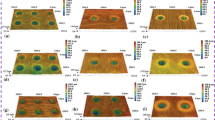Abstract
Laser surface modification of contact surfaces, which can generate arranged channels or micro-dimples, is an important factor that dictates several improvements in tribological performance, including lubrication lifetime, wear resistance, load-carrying capacity, and reduced friction coefficients. Patterns of combined textures having circular and sine wave shapes were created using an Nd:YAG laser. Pin-on-disk tribometer tests under oil lubrication were conducted over a range of test conditions. Moreover, an L9(34) orthogonal array experimental design was employed to determine the influence of parameters such as the area density, applied load, and sliding speed on the tribological characteristics. The results indicate that the combined textures effectively reduced the coefficient of friction compared with that of a polished surface. Among the investigated patterns, the texture with a 100-μm-groove-width pattern exhibited the lowest friction coefficient and wear rate. Analysis of variance suggested that the dimple density is the most important parameter influencing the friction coefficient at a confidence level of 95%.








Similar content being viewed by others
References
C.D. Reséndiz-Calderon, G.A. Rodríguez-Castro, A. Meneses-Amador, I.E. Campos-Silva, J. Andraca-Adame, M.E. Palomar-Pardavé, and E.A. Gallardo-Hernández, Micro-Abrasion Wear Resistance of Borided 316L Stainless Steel and AISI 1018 Steel, J. Mater. Eng. Perform., 2017, 26, p 5599–5609
J.J.C. Hoo, Creative Use of Bearing Steels, ASTM International, West Conshohocken, 1993
M.-K. Tang, X.-J. Huang, J.-G. Yu, X.-W. Li, and Q.-X. Zhang, The Effect of Textured Surfaces with Different Roughness Structures on the Tribological Properties of Al Alloy, J. Mater. Eng. Perform., 2016, 25, p 4115–4125
D.Z. Segu and P. Hwang, Friction Control by Multi-shape Textured Surface Under Pin-On-Disc test, Tribol. Int., 2015, 91, p 111–117
J. Moravčíková, R. Moravčík, M. Kusý, and M. Necpal, Influence of Laser Surface Texturing on Tribological Performance of Tool Steels, J. Mater. Eng. Perform., 2018, 27, p 5417–5426
G. Kibria, B. Doloi and B. Bhattacharyy, Experimental Investigation and Multi-objective Optimization of Nd:YAG Laser Micro-Turning Process of Alumina Ceramic Using Orthogonal Array and Grey Relational Analysis, Opt. Laser Technol., 2013, 48, p 16–27
D.Z. Segu, S.G. Choi, J.H. Choi, and S.S. Kim, The Effect of Multi-scale Laser Textured Surface on Lubrication Regime, Appl. Surf. Sci., 2013, 207, p 58–63
Z. Wu, Y. Xing, P. Huang, and L. Liu, Tribological Properties of Dimple-textured Titanium Alloys Under Dry Sliding Contact, Surf. Coat. Technol., 2017, 309, p 21–28
X. Youqiang, D. Jianxin, F. Xiuting, and Y. Sheng, Effect of Laser Surface Texturing on Si3N4/TiC Ceramic Sliding Against Steel Under Dry Friction, Mater. Des., 2013, 52, p 234–245
S. Yuan, W. Huang, and X. Wang, Orientation Effects of Micro-grooves on Sliding Surfaces, Tribol. Int., 2011, 44(9), p 1047–1054
K.H. Zum Gahr, R. Wahl, and K. Wauthier, Experimental Study of the Effect of Microtexturing on Oil Lubricated Ceramic/Steel Friction Pairs, Wear, 2019, 267(5–8), p 1241–1251
H. Hata, T. Nakahara, and H. Aoki, Measurement of friction in lightly load hydrodynamic sliders with striated roughness, in Proceedings of the Winter Annual Meeting of the American Society of Mechanical Engineers, (Chicago, Illinois, 1980) p. 75–92
S. Baskaran, V. Anandakrishnan, and M. Duraiselvam, Investigations on Dry Sliding Wear Behavior of in situ Casted AA7075–TiC Metal Matrix Composites by Using Taguchi Technique, Mater. Des., 2014, 60, p 184–192
D.Z. Segu, J.H. Kim, S.G. Choi, Y.S. Jung, and S.S. Kim, Application of Taguchi Techniques to Study Friction and Wear Properties of MoS2 Coatings Deposited on Laser Textured Surface, Surf. Coat. Technol., 2013, 232, p 504–514
R. Pundir, G.H.V.C. Chary, and M.G. Dastidar, Application of Taguchi Method for Optimizing the Process Parameters for the Removal of Copper and Nickel by Growing Aspergillus sp., Water. Resour. Ind., 2018, 20, p 83–92
L.H. Bin and M.Y. Gang, Hydrodynamic Lubrication Analysis of Textured Surfaces with the Domain Composition Method Method-effect of Texture Distribution Patterns, Trib., 2007, 6, p 175–176
M.S. Suh, Y.H. Chae, S.S. Kim, T. Hinoki, and A. Kohyama, Effect of Geometrical Parameters in Micro-grooved Cross Hatch Pattern Under Lubricated Sliding Friction, Tribol. Int., 2010, 43(8), p 1508–1517
H.L. Costa and I.M. Hutchings, Hydrodynamic Lubrication of Textured Steel Surfaces Under Reciprocating Sliding Conditions, Tribol. Int., 2007, 40, p 1227–1238
H. Fan, T. Hu, Y. Zhang, Y. Fang, J. Song, and L. Hu, Tribological Properties of Micro-Textured Surfaces of ZTA Ceramic Nanocomposites under the Combined Effect of test Conditions and Environments, Tribol. Int., 2014, 78, p 134–141
G. Taguchi and S. Konishi, Taguchi methods, Orthogonal Arrays and Linear Graphs, Tools for Quality Engineering, American Supplier Institute, Dearborn, 1987
P.J. Ross, Taguchi Technique for Quality Engineering, McGraw-Hill, New York, 1988
Acknowledgment
This work was supported by the National Research Foundation of Korea (NRF) grant funded by the Korea government (MSIT) (No. 2019R1A5A8080290). In addition, this work was supported by Korea Institute for Advancement of Technology (KIAT) grant funded by the Korea Government (MOTIE) (P0002092, The Competency Development Program for Industry Specialist).
Author information
Authors and Affiliations
Corresponding authors
Additional information
Publisher's Note
Springer Nature remains neutral with regard to jurisdictional claims in published maps and institutional affiliations.
Rights and permissions
About this article
Cite this article
Segu, D.Z., Lu, C., Hwang, P. et al. Optimization of Tribological Characteristics of a Combined Pattern Textured Surface Using Taguchi Design. J. of Materi Eng and Perform 30, 3786–3794 (2021). https://doi.org/10.1007/s11665-021-05673-9
Received:
Revised:
Accepted:
Published:
Issue Date:
DOI: https://doi.org/10.1007/s11665-021-05673-9



